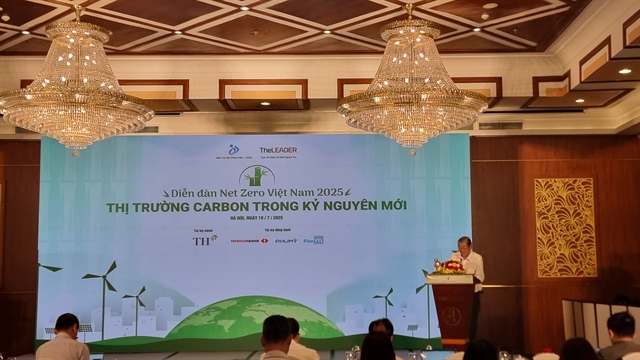At the Việt Nam Net Zero Forum 2025, held on July 18 in Hà Nội, three standout initiatives were highlighted: rice–shrimp rotational farming in Cà Mau, forest protection in Cao Quảng commune, and circular economy practices in waste management.

HÀ NỘI — From the salt-tolerant rice fields of Cà Mau to the quiet forests of Cao Quảng, and even the sprawling landfills of major cities, Việt Nam’s pathway to net-zero emissions is being shaped by locally adapted, grounded models.
These are not headline-grabbing technological breakthroughs, but deliberate, nature-based solutions rooted in community ownership and resource circularity, making use of what was once discarded.
At the Việt Nam Net Zero Forum 2025, held on July 18 in Hà Nội, three standout initiatives were highlighted: rice–shrimp rotational farming in Cà Mau Province, forest protection in Cao Quảng Commune, and circular economy practices in waste management. Together, they exemplify how Việt Nam is forging a pragmatic and sustainable route to achieving net zero emissions by 2050.
Agriculture, both a major source of greenhouse gas emissions and one of the sectors most vulnerable to climate change, is finding renewed promise through the rice–shrimp rotational model on the Cà Mau peninsula. This approach offers a dual advantage, ecological sustainability and economic resilience.
Hồ Quang Cua, renowned for developing the world-famous ST25 rice variety, said: “Cultivating healthy soil and crops is at the heart of circular agriculture. Mid-season drainage enhances microbial activity, accelerates organic decomposition, and helps lower greenhouse gas emissions.”
By taking advantage of natural salinity shifts, farmers alternate between shrimp farming during the dry season and rice cultivation in the rainy season. This cyclical model supports the local ecosystem while reducing reliance on chemical fertilisers and pesticides.
The use of ST25 rice and drainage techniques has enabled many households to reduce chemical fertiliser use by 30 per cent, cut pesticide application by 75 per cent, and double their income compared to conventional farming methods.
Beyond its clear environmental and economic benefits, the model also holds potential for carbon credit generation – provided it meets low-emission criteria.
“Circular agriculture allows us to recycle essential nutrients like phosphorus, potassium and organic matter from rice straw. It also leverages atmospheric nitrogen, cutting dependency on chemical fertilisers,” Cua added.
In central Việt Nam, forests are playing a quiet but vital role in the nation’s Net Zero journey. In Cao Quảng Commune (now in Quảng Bình Province), thousands of hectares of once-degraded natural forest have been revitalised, supported by forest allocation policies and international development programmes.
Nguyễn Quang Huy, representing the Cao Quảng forest community, said: “Once the forest boundaries were clearly defined, people felt true ownership. That sparked a genuine sense of responsibility to protect and restore the forest, and pass it on to future generations.”
This shift in mindset has turned Cao Quảng’s forests into vital carbon sinks. Since 2023, under the North Central Region Emission Reductions Purchase Agreement (ERPA), local communities have received nearly VNĐ3 billion (US$114.7 thousand) annually for forest protection, a modest yet encouraging source of income.
However, Huy stressed that lasting commitment to forest conservation requires supportive policies that ensure transparent, effective participation in the carbon credit market.
“We hope the Government will soon activate the carbon market so that our forest protection efforts can be fairly recognised and rewarded,” he said.
While the rice–shrimp and forest protection models exemplify nature-based solutions, circular waste management represents a proactive effort to transform waste into value.
At the forum, Lê Quang Linh, an expert from Giant Barb Science and Environment Joint Stock Company, outlined four key strategies to reduce emissions from waste: producing biochar from agricultural residues, recovering biogas from livestock farming, capturing landfill gas for energy and incinerating waste to generate electricity.
Linh said: “Biochar made from rice straw, coffee husks, and rice husks not only improves soil health but also reduces carbon emissions by 10 to 12 per cent.
"Methane from livestock is 25 times more potent than CO2, but treating it through biogas systems cuts emissions and earns carbon credits.
"One ongoing biogas programme is issuing around 928,000 credits annually, with carbon revenues accounting for up to 50 per cent of its operating budget."
Furthermore, Việt Nam could generate up to 200MW of electricity by capturing landfill gas or incinerating 4,000 tonnes of waste daily, significantly easing its reliance on fossil fuels.
These locally adapted, community-driven initiatives underscore Việt Nam’s growing capacity to contribute meaningfully to global climate goals, not only through firm commitments, but also through homegrown innovation grounded in its natural strengths and resilient communities. — VNS





